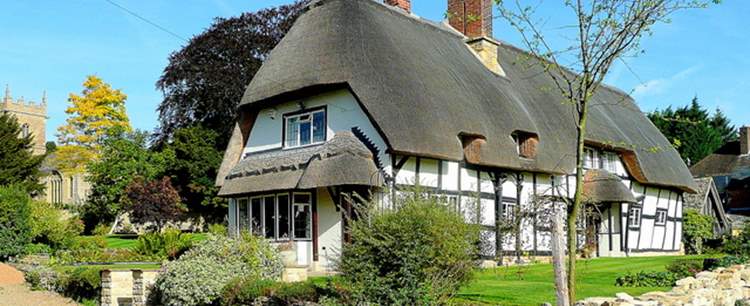Contents
When looking through estate agents’ listings, talking to mortgage lenders or to insurers, from time to time you are likely to come across references to non-standard construction properties.
The use of that word “non-standard” already suggests that there is something different, or something special, about the property, which sets it apart from its neighbours. That distinction might often – but by no means always – mean that the home in question also commands a higher than average market price, and be more likely to attract a high net worth individual, rather than an owner of more modest means.
All of this has ramifications not just for your ownership of such a property, but just as importantly, the insurance you arrange to safeguard and protect it – and its contents – against such potentially major risks as fire, storm damage, flooding, subsidence, impacts, theft and vandalism.
Just as your home might be non-standard construction, so too are you likely to need non-standard insurance.
To understand why that is necessary, this guide shines a light on the following questions:
- what is a non-standard property;
- why are homes of non-standard construction more expensive to insure;
- what should I do if I have a non-standard risk in my property;
- what will the insurer need to know; and
- how do I calculate the sum insured?
What is a non-standard property?
Probably the best way of defining a non-standard property is to describe a standard property.
One that is built to standard construction, design and use of materials is, at its simplest:
- a home with walls built of brick or stone; with
- a roof clad with tiles or slates.
Any other type of design or use of materials may be said to be a non-standard construction property.
Examples of the types of properties / circumstances that may be classed as non-standard include…
- properties in a high flood risk area;
- unoccupied properties;
- non-standard construction;
- criminal convictions;
- properties affected by subsidence;
- adverse claims experience;
- let properties;
- holiday homes;
- properties undergoing renovation;
- bespoke requests and requirements;
- flats/ maisonettes & houses converted into flats/ maisonettes;
- previous insurer declinature/ cancellations/ voidance;
- high risk occupations;
- extended unoccupancy (such as you are working away from home or having a long holiday);
- listed properties;
- older properties;
- shared occupancy/ lodgers;
- business use (but not commercial premises);
- bed & breakfast (but not guest house/ hotel).
An article in the Journal of Building Appraisal cites the particular difficulty for property surveyors when compiling reports on mass-produced housing units, that were commonly built in times of pressing social housing need, and describes these as being of non-traditional construction.
For the purposes of this guide, however, it is important to consider how non-standard construction techniques and materials may, in fact, enhance the interest, appeal and value of a building – making its protection with suitable, specialist non-standard construction property insurance even more critical.
Examples of such high value properties – marked out from their neighbours by innovative or distinctive non-standard construction techniques and materials are:
Listed buildings
- certain buildings are listed because of their special architectural or historic interest;
- listing immediately distinguishes a building as special – a distinction which typically adds value to the property – and commonly incorporates non-standard construction techniques and materials;
- in England, the formal decision to list a building is done by an organisation called Historic England, which inscribes the designated property onto the National Heritage List for England (NHLE);
- the list comprises some half a million inscriptions, and the older the building, the more likely it is to appear on the list;
- buildings which are more than 350 years old, for example, and in more or less their original state, are invariably listed, as are the majority of those aged between 250 and 350 years, with any other building more than 30 years might also be considered of architectural or historic interest;
- in Wales, inscriptions of listed buildings – referred to in Welsh as “coflein” (from the word “cof” meaning memory and “lein” meaning line – are made by Historic Wales and the Royal Commission on the Ancient and Historical Monuments of Wales (RCAHM);
- Scotland’s 47,000 or so listed buildings are recorded by Historic Scotland, in accordance with the Planning (Listed Buildings and Conservation Areas)(Scotland) Act of 1997;
- the formal listing of buildings of special historic and architectural interest came to Northern Ireland somewhat later than the rest of the UK and is today the responsibility of the Historic Environment Division of the Department for Communities on behalf of the Northern Ireland Executive;
- wherever a building gains a UK listing, one of the critical impacts is the control exercised by the region’s and local council’s planning authorities – tight restrictions, designed to prevent alterations, extensions or changes to the character and appearance of the building, so that it is preserved in its present state for the enjoyment of future generations;
Graded buildings
- another form of non-standard property is a graded building – so called because of the different grades of listed building throughout England, Wales, Scotland and Northern Ireland;
- in England and Wales, for example, listed buildings maybe Graded I, II* or II – with some 95% of them Grade II (which attracts the least restrictive, but no less strict planning regulations);
- in Scotland, there are Grades A to C – with Grade C allowing some freedom to alter or change the appearance of the listed building;
- Northern Ireland has four categories, Grade A, B+, B1 and B2 – with planning restrictions lightest with respect to Grade B2 buildings;
Thatched cottages
- the home of the quintessential English village is the thatched cottage – with a picturesque appeal which invariably commands a high market price and a home, therefore, often sought by individuals of high net worth;
- a thatched cottage is clearly a property of non-standard construction, because of its roof;
- the Thatch Advice Centre explains that there are three main types of thatch in use in the UK – Longstraw, Combed Wheat Reed, Water Reed and other, less widely used materials;
- Water Reed – also known as Continental Water Reed or Norfolk Reed – is probably the most common, because it is so hard wearing and long lasting;
- changing the existing material with which the building is thatched may require listed building planning permission;
Property vulnerable to flooding
- some properties might not be built using non-standard techniques and materials, but are nevertheless vulnerable to risks and perils not encountered by the general run of home;
- these are properties which have either suffered flooding in the past or appear vulnerable to the threat in certain weather conditions – and areas which fall into this category might be located by using the Environment Agency’s scalable map showing the risk of flooding from rivers and the sea;
- properties in these locations might be as high value homes as many others, but their vulnerability to the risk of flooding increases their chances of loss or damage.
Focusing on high net worth homes, non-standard construction properties may take a variety of forms – and the principal ones have been described here. Although they may be widely different in appearance and value, they all share particular issues when it comes to home building and contents insurance
Why are homes of non-standard construction more expensive to insure?
Insurers tend to like nothing better than the familiar and nothing out of the ordinary, since the known risks are much easier to assess and to calculate the likely costs in the event of loss or damage.
In the case of residential property, of course, the maximum pay out an insurer may face is the rebuild value of the home following a major disaster, such as fire, explosion, flooding or other event which leaves the building beyond repair.
The difficulty facing the insurer then is how to assess the potential cost of rebuilding a property for which there are so few comparisons, where unfamiliar construction techniques have been employed and rarely used materials incorporated into the structure.
Those unknowns and uncertainties are the principal reasons for homes of non-standard construction being more expensive to insure. For a regular insurer, with little experience in providing cover for such properties, policies may be even more expensive – and that is why you might want to consult a specialist provider, such as ourselves here at UKinsuranceNET for the cover you need for your non-standard construction property, but at a competitively priced rate.
So, how does specialist insurance relate to the various categories of non-standard property that have been identified?
Listed buildings
In the case of listed building insurance, the risk is complicated not only by the high probability of it being of non-standard construction, but the added problem that any repairs or reinstatement following loss or damage but also comply with the strict planning regulations attached to such property.
Maintaining and reproducing original non-standard construction techniques and incorporating building materials that might be difficult to source, invariably increases the cost of any repairs or reinstatement – thus further increasing the financial risks to insurers in the settlement of any claim.
Graded buildings
Out of an estimated 500,000 listed buildings, approximately 95% – or 475,000 – are estimated to be listed as Grade II buildings.
Given those numbers, graded buildings include many different types of home – the large proportion of which are of non-standard construction and, very often, high value homes.
So, a Grade II listed property is a special case and one that calls for specialist cover in the form of tailor-made Grade II home insurance.
As the owner of such a special category of home, you are in search of the highest standards in insurance cover – the top-class standards reflected in a five-star rating by insurance industry experts Defaqto, and those which we are proud to offer on our products here at UKinsuranceNET.
Thatched cottages
Specialist thatched cottage insurance also takes into account that properties built in this way are classified as non-standard construction – the roof is thatch, rather than the standard clay tile or slate.
Insurance for thatched cottages reflects the special risks and perils that accompany such a roofing material – most notably, of course, the risk of fire.
Devon and Somerset Fire and Rescue Service have commented on the increasing popularity of thatched roofs and notes that, although fires are uncommon, 90% of them arise through faults in chimneys and flues. Furthermore, your thatched roof is designed to repel water and this makes extinguishing any such fire so much more difficult.
When arranging thatched building insurance, your insurer may insist on a number of straight forward, but special, precautions that need to be taken to mitigate the risk of loss or damage to the property as a result of the thatch catching fire.
Properties vulnerable to flooding
While the new Flood RE scheme has been set up to help homeowners who live in a flood risk area find affordable home insurance, properties vulnerable to flooding are often still difficult to insure.
Even those that can be insured may attract prohibitively expensive premiums.
Homes that have previously suffered a flood – especially high net worth or non-standard construction homes – may find that the only time they can get flood cover is if they accept an exceptionally high excess on any flood claim. Amounts running in to thousands of pounds are not uncommon.
At UKinsuranceNET, we can help insure your flood excess up to £50,000. This is a standalone policy that is designed to cover any excess you may be liable to pay in the event of a successful claim for flood damage.
What should I do if I have a non-standard risk in my property
It has previously been noted that standard building construction involves the use of brick or stone for the walls and tiles or slate for the roof – the incorporation of any other materials or construction techniques represent non-standard construction.
Where there are elements of non-standard materials used in the construction of your property, insurance is likely to be more difficult to obtain – at a competitive price – because of the assessed expense of those building materials, the difficulties in obtaining them, a greater risk to loss or damage through flooding or fire, and the limited number of tradesmen and craftsmen who have the necessary skills for repairing or reinstating such a building.
As the number of non-standard risks in your property grows, so it becomes more difficult to secure the insurance specifically tailored to the needs of your home.
Yet the potential for the inclusion of non-standard materials is huge and might be indicated in the use of …
- Glass – in structural use:
- asbestos;
- flint;
- concrete;
- prefabricated materials – whether combustible or non-combustible;
- corrugated iron;
- timber frames with brick walls; and
- timber frames with plaster panels.
Non-standard materials that might be present in the roof of your property include:
- asphalt;
- asbestos;
- corrugated iron;
- concrete;
- glass;
- felt on timber;
- shingles; and, of course
You might already be aware that materials such as these have been used in the construction of your home, or their use might have been revealed during a professional survey.
In either event, it is important that your insurer is accurately and fully informed about these non-standard risks – if you have avoided passing on such information and subsequently make an insurance claim, your insurer may be entitled to refuse the claim on the grounds of your failing to disclose “material facts” about the property.
A more detailed consideration of the dangers of failing to disclose or misrepresent material facts when arranging your insurance is discussed by the Financial Ombudsman Service.
Rather than hoping that you have made a sufficiently forthright disclosure – about non-standard risks you already know to be present or those which have been revealed by a professional survey – a more prudent course is likely to lie in consulting a specialist provider, with the expertise and experience of arranging insurance for non-standard construction properties.
Just such a specialist provider is ready and waiting here at UKinsuranceNET to offer the advice and guidance you may need.
What will the insurer need to know?
In addition to the construction materials that have been used to build your home, your insurer may also need to know a number of other important issues regarding its use and past history.
Non-standard risks about which your insurer needs to know might include:
Flooding
- if there is a history of flooding in your area – and especially if there has been flood damage to your home – your insurer needs to know;
- such a history of flooding is considered by the insurer to pose a greater risk of flooding in the future – with the potentially very high claims invariably associated with flood damage;
Subsidence
- your insurer also needs to know whether the property has any history of subsidence – or whether there is any risk of the problem developing;
- subsidence is many home owner’s worst nightmare – and insurers’ too – because of the difficulty and expense of remedying the problem;
- since some home insurance policies provide cover against subsidence and others do not, you might want to ensure that your home is adequately covered;
Foundations
- a non-standard risk agreement may also be necessary if the building’s foundations have ever been structurally altered or repaired;
- standard home insurance is unlikely to provide the cover you need;
Home working
- if you are planning to use your home as a permanent base for work, this may also affect the way in which any insurer assesses the risks;
- home workers insurance may ensure this non-standard risk is covered.
Once again, your overriding concern needs to be a full and accurate disclose of any aspect of the building’s construction or use which might be regarded as non-standard. If non-standard risks are disclosed, it does not mean to say that an insurer is automatically going to decline cover, simply that those special risks need to be taken into account.
If you fail to inform your insurer about these risks, on the other hand, you may have a rude awakening if and when you need to make a claim for loss or damage to your home, only to find it rejected.
Calculating the sum insured
Arranging insurance for your home requires a calculation of the value of its physical structure and contents, so that there is sufficient cover to enable repairs or reinstatement to be made following some insured event.
Where non-standard risks are involved, making that calculation may be more difficult and involved – but no less important.
The objective is to ensure that you are neither over- nor underinsured. If you are overinsured, you are probably paying more in premiums than the risks demand; but if you are underinsured, there is the grave danger that in the event of any claim, you receive an insufficient amount in settlement to repair or replace any damage or loss.
So, how do you calculate the total sums that need to be insured?
Buildings
- calculating building insurance involves anticipation of the worst case scenario in which the structure and fabric of the property is destroyed beyond repair – by a fire that rages out of control, for example;
- in that event, you need a sufficient sum insured to cover the costs associated with clearing the site, completely rebuilding your home, and paying the various legal costs (surveyors, architects, lawyers and planning applications);
- in the case of a non-standard construction property, this calculation is considerably more difficult than usual;
- reconstruction costs – all those associated with rebuilding your property, and not what you paid for your home or its current market value – are made more difficult if non-standard construction techniques are required, hard to source building materials are needed, special planning permission is required (in the case of a listed or Graded building, for example) and specialist craftsmen and tradesmen also need to be found;
- for these reasons, you are likely to need the services of a suitably qualified professional – such as a valuer or surveyor – to make the required valuation;
Grounds and outbuildings
- where a higher value, non-standard property is concerned, the grounds and outside facilities are also likely to be more extensive than usual;
- sufficient cover needs to be provided for reinstatement of landscaping, and the repair or reinstatement of such features as swimming pools and outbuildings;
- since these are elements where cover is frequently restricted in many standard home insurance policies, you might want to be certain to arranged specialist high net worth insurance to meet the non-standard risks associated with extensive grounds and outdoor facilities;
Contents insurance
- if you own a high value, non-standard construction home, the chances are that your tastes for the out of the ordinary are also reflected in the possessions you own in the contents of your home;
- antiques, fine art, other collectables, expensive watches and valuable jewellery – your own private wine cellar, maybe – are all items you might find in a high net worth property;
- even a single piece of fine art may command a high value, says the Red Rag Gallery and is likely to be increasing in value at the rate of 5.6% a year, according to forecasts by Art Market;
- this may help highlight various shortcomings with respect to the cover provided by standard home contents insurance policies – which not only have a clearly defined limit on the total amount insured, but also the maximum that may be paid out on any single item;
- those limits may be as low as £1,000 to £2,000 in the case of standard home insurance policies and, therefore, quite inadequate for the protection of your collection of fine art, jewellery or other valuables;
- more likely to meet your needs are the specialist high net worth home insurance policies we provide here at UKinsuranceNET, where our high net worth contents insurance policies offer from £75,000 to £250,000 of cover;
- we also offer bespoke fine art insurance, high value jewellery insurance and collectables cover;
Alternative accommodation
- in the event of a major insured event, you are also likely to need alternative accommodation whilst repairs or rebuilding is carried out on your home;
- although the provision of alternative accommodation may be included in many other home insurance plans, the policies we provide here at UKinsuranceNET reflect the longer periods of time that are likely to be involved in repairs or reinstatement of a non-standard construction property;
- for that reason, our high-end policies include provision for up to two full years of alternative accommodation, if that is required;
Property owner’s liability
- any property owner has a duty of care to take all reasonable precautions against the risk of injury or property damage to visitors, neighbours and members of the public;
- for that reason, many standard home insurance policies typically include property owner’s liability indemnity of about £1 million;
- in the case of a high net worth property – especially one that features non-standard construction techniques or materials, or is of special historic and architectural interest – claims like this may quite easily exceed £1 million;
- that is why the non-standard home insurance policies we arrange here at UKinsuranceNET provide property owner’s liability cover for as much as £5 million or even £10 million.
Summary
Homes incorporating non-standard construction techniques and materials are many and varied.
They may be listed buildings, Graded buildings, thatched cottages, or any other home where non-standard risks and perils may make them unusual and out of the ordinary – distinctions which are anathema to many regular insurers.
In response to relatively unknown risks that are difficult to evaluate in financial terms, most insurers need to charge higher than usual premiums to cover against loss or damage to a non-standard construction home.
Nevertheless, there are specialist providers of competitively priced insurance for higher value, non-standard construction homes – such as ourselves here at UKinsuranceNET.
If you have a home which is exposed to non-standard risks – and these may be many and varied – it is important to keep your insurer fully and accurately informed. Your failure to do so may result in any subsequent claim being denied through your failure to disclose or to misrepresent material facts.
When you are calculating the total sums that need to insured, you might want to keep firmly in mind that specialist, high net worth insurance policies exist to provide higher than normal limits on the risks and the amounts for which you may claim.







